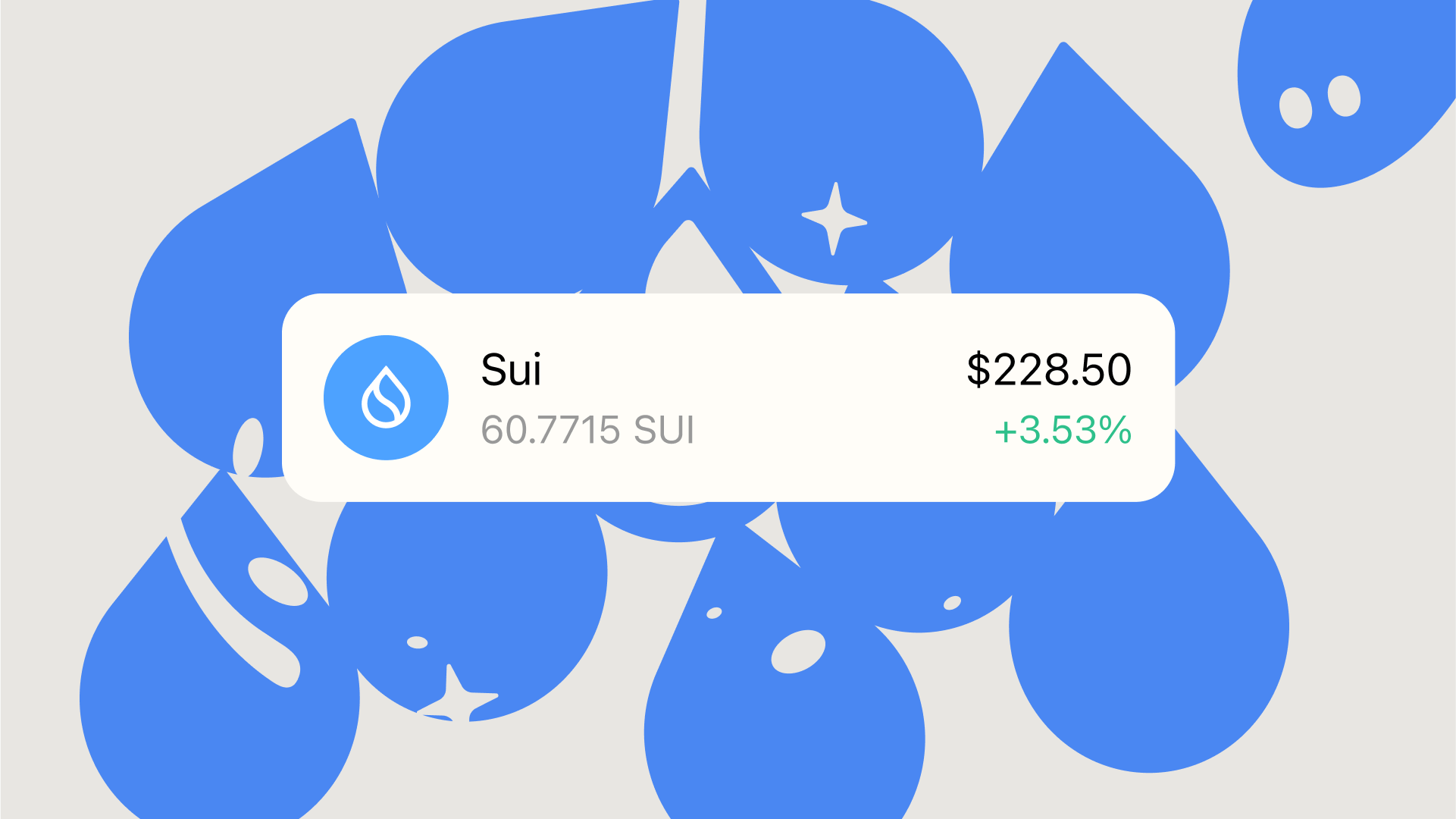The blockchain landscape is constantly evolving, with new platforms emerging to address scalability, cost, and user experience (UX) challenges.
One of the newest blockchain entrants is Sui, built by the brains at Mysten Labs.
It’s not just another blockchain with a sleek name—it’s a reimagined Layer-1 with speed, style, and some seriously clever tech under the hood that makes other chains look like dial-up.
In this guide, we’ll break down what makes Sui tick, how it stacks up against heavyweights such as Ethereum and Solana, and why it might just be the dark horse of the next crypto wave.
What is Sui?
Sui is a Layer-1 blockchain developed by a team of former Meta engineers who contributed to Diem.
Diem, initially known as Libra, was Meta's attempt to create a global digital currency and payment system. However, regulatory challenges led to Diem's discontinuation. Subsequently, Evan Cheng, Sam Blackshear, Adeniyi Abiodun, George Danezis, and Kostas Chalkias leveraged their expertise from Diem to establish Mysten Labs.
Their goal? Address the scalability and performance limitations they encountered during the Diem project. This initiative resulted in the creation of Sui. Officially launched in 2023, Sui's primary goal is to redefine scalability, simplicity, and user experience in the onchain economy.
How does Sui work?
Sui leverages a combination of new technologies to achieve high throughput, low latency, and efficient transaction processing:
- Move programming language: At the core of Sui's architecture is the Move programming language, originally developed by Meta for the Diem project. Unlike traditional smart contract languages such as Ethereum’s Solidity, Move is built with security in mind, minimizing common vulnerabilities in smart contract development.
- Object-centric model: Departing from the conventional account-based model, Sui employs an object-centric data model where each asset is represented as a distinct object with its own unique identifier and ownership. Essentially, the object-centric model simplifies the development of complex applications by enabling developers to interact with assets directly, enhancing composability and modularity.
- New consensus mechanism: Sui's consensus mechanism is designed to optimize transaction processing by distinguishing between simple and complex transactions. This dual-path approach enhances scalability while maintaining robust security guarantees. Also, it means transactions are confirmed almost instantly, providing a seamless user experience for high-speed applications in e.g. payments and gaming.
- Parallel transaction execution: Sui introduces parallel transaction execution to overcome the bottlenecks associated with sequential processing in blockchains such as Ethereum. By identifying and executing independent transactions simultaneously, Sui significantly increases throughput and reduces latency. In combination with the consensus mechanism, this parallelism is particularly beneficial for applications requiring high-speed processing.
- Horizontal scalability: Sui's architecture supports horizontal scalability, enabling the network to handle increased demand by adding more validators. This scalability ensures that the network can maintain high performance and low fees even as usage grows. Additionally, Sui's storage model is designed to be cost-effective and scalable, allowing developers to store complex assets onchain without incurring prohibitive costs.
Sui vs. Ethereum vs. Solana
While Ethereum remains the most established blockchain, its low transaction speed and high fees make it less suitable for certain applications, particularly onchain payments and gaming.
Both Solana and Sui present compelling alternatives, particularly for applications that demand high performance. Their low transaction costs further enhance their appeal, enabling microtransactions and frequent interactions without burdening users with high fees.
These features position both Solana and Sui as frontrunners for developers and businesses seeking to optimize performance without compromising affordability. As the demand for scalable, low-cost blockchain solutions grows, Solana and Sui are, therefore, well-poised to play pivotal roles in shaping the future of decentralized applications
Most prominent applications on Sui
Suilend
Suilend is a decentralized lending and borrowing platform built on the Sui blockchain. It enables users to lend their crypto assets to earn interest or borrow against their holdings.
NAVI
NAVI provides a comprehensive suite of decentralized finance(DeFi) services designed to enhance liquidity management. These include lending and borrowing capabilities, leveraged yield farming opportunities, and isolated liquidity pools that enable users to mitigate risks while optimizing returns.
Cetus
Cetus is a decentralized exchange (DEX) that offers liquidity pools and token swaps. Its design focuses on providing users with low slippage and minimal fees when trading.
Haedal
Haedal is a liquid staking protocol that enables users to stake their SUI tokens while maintaining liquidity. By leveraging Haedal, users can earn staking rewards without locking their assets, as they receive liquid staking derivatives that can be used across Sui's DeFi landscape.
Scaling Sui: The friction points
Although Sui has made significant strides, the network is not without challenges:
- Adoption hurdles: Sui, despite its innovative features and high performance, faces significant challenges in attracting developers and users within the competitive blockchain space. Established platforms such as Ethereum and Solana have built large, loyal communities and robust ecosystems, making it difficult for newcomers to capture attention. To overcome this, Sui must showcase its unique advantages, such as its object-centric model and high scalability, while offering incentives such as developer grants, hackathons, and comprehensive tooling to lower the barrier to entry for new projects.
- Ecosystem growth: A thriving ecosystem of platforms and applications is essential for Sui's success. This includes a diverse range of payment solutions, DeFi applications, and gaming platforms. The network must also foster partnerships with enterprises and infrastructure providers to build out wallets and developer tools. A dynamic and expanding ecosystem not only attracts developers but also drives user adoption, creating a virtuous cycle of growth.
- Regulatory uncertainty: Operating in an ever-changing regulatory landscape presents challenges for Sui, as governments worldwide introduce new laws and policies targeting blockchain technology. Sui's ability to adapt to these regulations while maintaining its core functionality will be crucial for building trust among institutions, developers, and users. Proactively engaging with regulators and adhering to compliance requirements can mitigate these risks, enabling Sui to position itself as a trustworthy and forward-thinking platform.
Regardless, Sui is poised to become a significant player in the onchain economy, especially regarding use cases requiring high-speed, low-cost transactions. Its innovative design, coupled with the expertise of Mysten Labs, gives it a strong foundation for long-term success.
As the onchain ecosystem grows and more developers build on the platform, Sui has the potential to reshape industries ranging from finance to gaming. If it continues to address challenges and capitalize on opportunities, Sui could become a leading benchmark for scalability and user-centric blockchain design.
How to trade SUI tokens with Phantom?
- Download Phantom and set up a wallet
- Fund your Phantom wallet
- Log in to your Phantom wallet
- Select "Swap" and the token (e.g. SUI or USDC) you'd like to use in the swap
- Next, open the dropdown menu in the “You receive” section and paste “0x2::sui::SUI” into the search bar
- After selecting your the SUI token, finalize your swap
How to share SUI with friends and family
Know someone else who might be interested in SUI tokens?
You can share a simple token page with them so they can get involved.
Here's how:
- Open Phantom
- Search for SUI
- Select the token
- Press the Share button
- Copy the link
- Send the link through your preferred app, such as iMessage, Telegram, Instagram, or others
For example, when you share this link, the recipient will receive the official SUI token page from Phantom
How to bridge tokens to Sui with Phantom?
If you’d like to bridge funds to Sui, use our very own Crosschain Swapper. With our Crosschain Swapper, you can bridge tokens across Solana, Ethereum, Base, Sui, and Polygon right in your Phantom wallet.
FAQ
Disclaimer: This guide is strictly for educational purposes only and doesn’t constitute financial or legal advice or a solicitation to buy or sell any assets or to make any financial decisions. Please be careful and do your own research.







